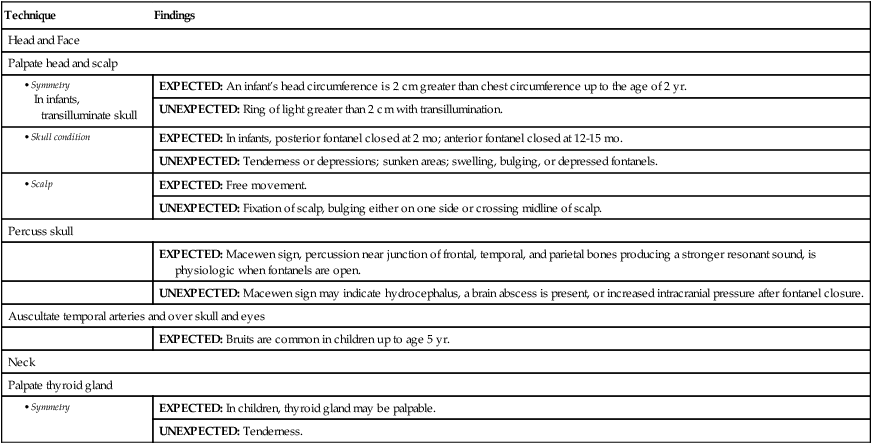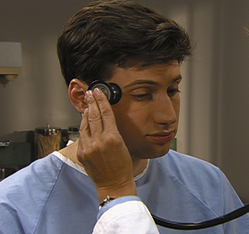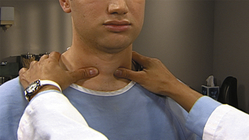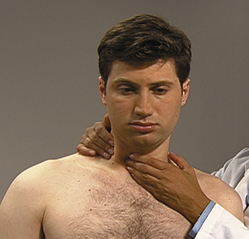Head and Neck
EXAMINATION
Ask patient to sit.

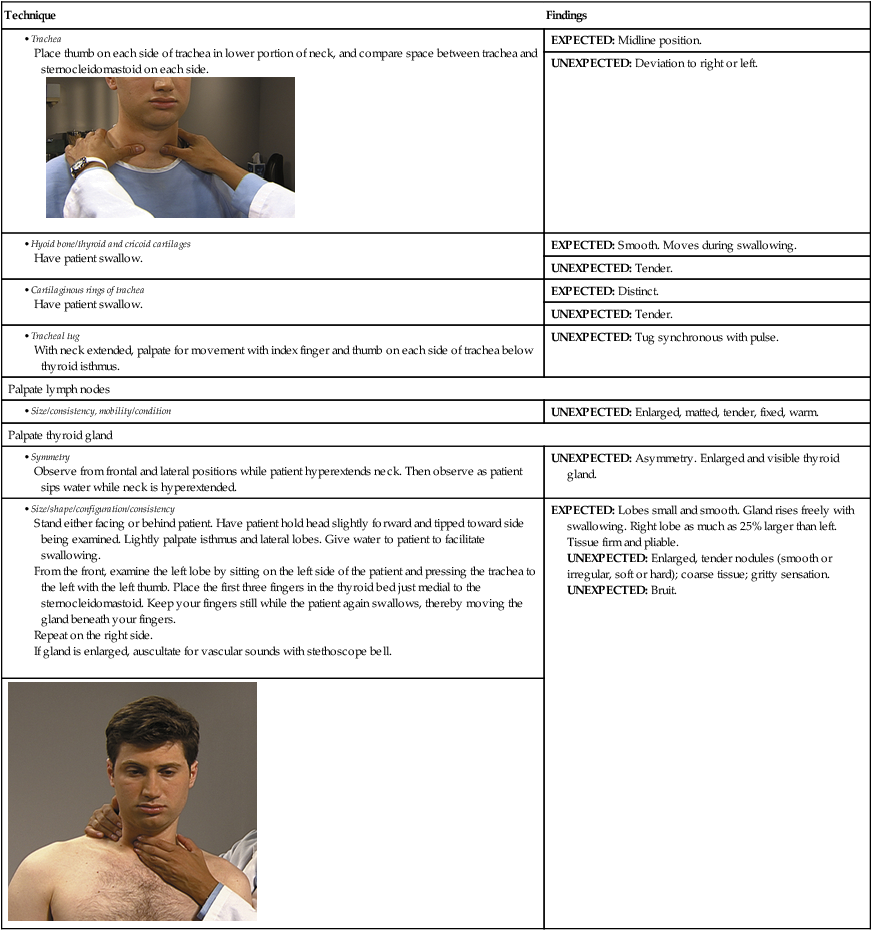
AIDS TO DIFFERENTIAL DIAGNOSIS
| Subjective Data | Objective Data |
| Myxedema | |
| Cognitive impairment, slowed mentation, poor concentration, decreased short-term memory, social withdrawal, psychomotor retardation, depressed mood, and apathy. | Dull, puffy, yellow skin. Coarse, sparse hair. Temporal loss of eyebrows. Periorbital edema. Prominent tongue. Hypothyroidism (see table on p. 66). |
| Graves Disease | |
| Symptoms of hyperthyroidism, palpitations, heat intolerance, weight loss, fatigue, increased appetite, tachycardia. | Diffuse thyroid enlargement, hyperthyroidism. Various pathologic conditions—ophthalmologic (prominent eyes, lid retraction, staring or startled expression), dermatologic (fine and moist skin, fine hair), musculoskeletal (muscle weakness), cardiac (tachycardia) (see table on p. 66). |

| Characteristic | Classic Migraine | Medication Rebound | Cluster | Hypertensive | Muscular Tension | Temporal Arteritis | Space-Occupying Lesion |
| Headaches are one of the most common concerns and probably one of the most self-medicated. They are not always benign. A history of insistent headache that is severe and recurrent must always be given attention. Sometimes the underlying cause is life-threatening, such as a brain tumor. Sometimes it affects daily activities. The patient’s history is fully as important as the physical examination in getting at the root of a headache. Various kinds of headaches can be compared as follows: | |||||||
| Age at onset | Childhood | Adulthood | Adulthood | Adulthood | Older adulthood | Any | |
| Location | Unilateral or generalized | Holocranial or diffuse | Unilateral | Bilateral or occipital | Unilateral or bilateral | Unilateral or bilateral | Localized |
| Duration | Hours to days | Hours | ½ to 2 hours | Hours | Hours to days | Hours to days | Rapidly increasing frequency |
| Time of onset | Morning or night | Predictably begins within hours to days of the last dose of the medication | Night | Morning | Anytime, commonly in afternoon or evening | Anytime | Awakening from sleep |
| Quality of pain | Pulsating or throbbing | Dull or throbbing | Intense burning, boring, searing, knifelike | Throbbing | Bandlike, constricting | Throbbing | |
| Prodromal event | Vague neurologic changes, personality change, fluid retention, appetite loss Well-defined neurologic event, scotoma, aphasia, hemianopsia, aura |
Daily analgesic use | Personality changes, sleep disturbances | None | None | None | Aggravated by coughing or bending forward |
| Precipitating event | Menstrual period, missing meals, birth control pills, letdown after stress | Abrupt discontinuation of analgesics | Alcohol consumption | None | Stress, anger, bruxism | None | Develops in temporal relation to the neoplasm |
| Frequency | Twice a week | Gradual increase in headache frequency to daily | Several times nightly for several nights, then none | Daily | Daily | Daily | Progressive |
| Sex predilection | Females | Females | Males | Equal | Equal | Equal | Equal |
| Other symptoms | Nausea, vomiting | Alternate or preventive medications fail to control the headache | Increased lacrimation, nasal discharge | Generally remits as day progresses | None | None | Vomiting, confusion, abnormal neurologic findings, gait abnormality, papilledema, nystagmus |
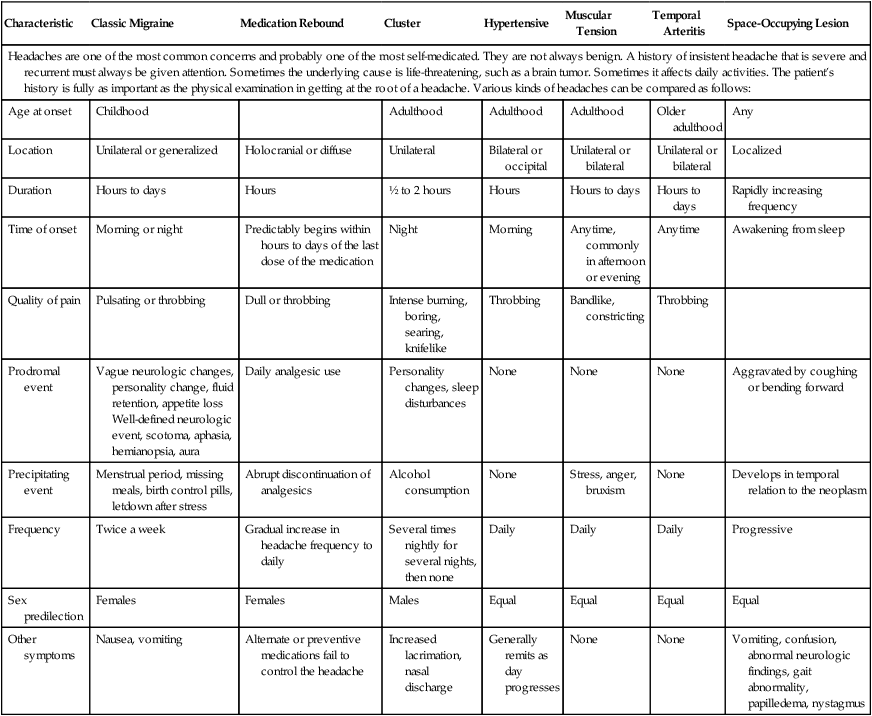
Hyperthyroidism versus Hypothyroidism
| System or Structure Affected | Hyperthyroidism | Hypothyroidism |
| Constitutional | ||
| Temperature preference | Cool climate | Warm climate |
| Weight | Loss | Gain |
| Emotional state | Nervous, easily irritated, highly energetic | Lethargic, complacent, uninterested |
| Hair | Fine, with hair loss; failure to hold permanent wave | Coarse, with tendency to break |
| Skin | Warm, fine, hyperpigmentation at pressure points | Coarse, scaling, dry |
| Fingernails | Thin, with tendency to break; may show onycholysis | Thick |
| Eyes | Bilateral or unilateral proptosis, lid retraction, double vision | Puffiness in periorbital region |
| Neck | Goiter, change in shirt neck size, pain over thyroid | No goiter |
| Cardiac | Tachycardia, dysrhythmia, palpitations | No change noted |
| Gastrointestinal | Increased frequency of bowel movements; diarrhea rare | Constipation |
| Menstrual | Scant flow, amenorrhea | Menorrhagia |
| Neuromuscular | Increasing weakness, especially of proximal muscles | Lethargic, but good muscular strength |
PEDIATRIC VARIATIONS
EXAMINATION
| Technique | Findings |
| Head and Face | |
| Palpate head and scalp | |
| EXPECTED: An infant’s head circumference is 2 cm greater than chest circumference up to the age of 2 yr. | |
| UNEXPECTED: Ring of light greater than 2 cm with transillumination. | |
| EXPECTED: In infants, posterior fontanel closed at 2 mo; anterior fontanel closed at 12-15 mo. | |
| UNEXPECTED: Tenderness or depressions; sunken areas; swelling, bulging, or depressed fontanels. | |
| EXPECTED: Free movement. | |
| UNEXPECTED: Fixation of scalp, bulging either on one side or crossing midline of scalp. | |
| Percuss skull | |
| EXPECTED: Macewen sign, percussion near junction of frontal, temporal, and parietal bones producing a stronger resonant sound, is physiologic when fontanels are open. | |
| UNEXPECTED: Macewen sign may indicate hydrocephalus, a brain abscess is present, or increased intracranial pressure after fontanel closure. | |
| Auscultate temporal arteries and over skull and eyes | |
| EXPECTED: Bruits are common in children up to age 5 yr. | |
| Neck | |
| Palpate thyroid gland | |
| EXPECTED: In children, thyroid gland may be palpable. | |
| UNEXPECTED: Tenderness. | |
